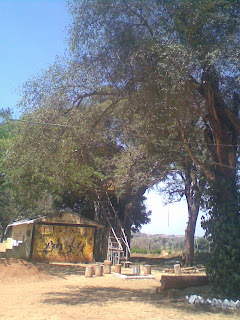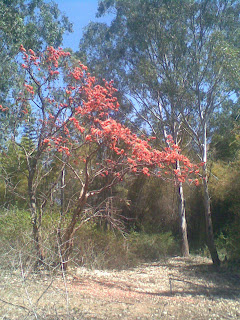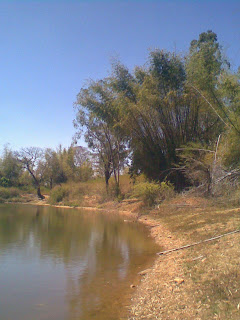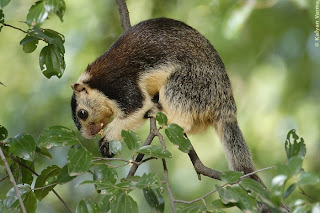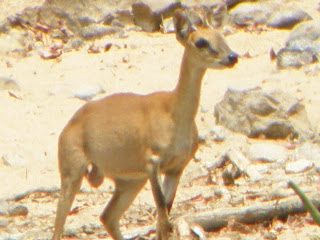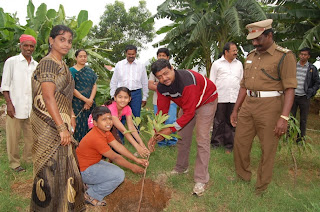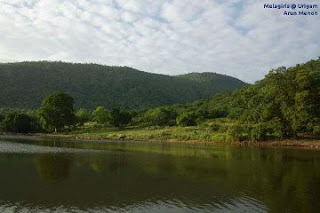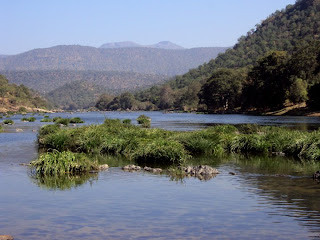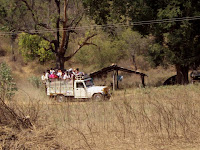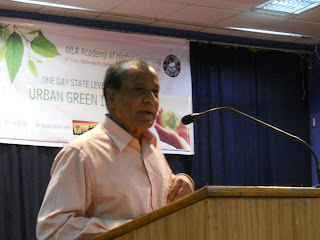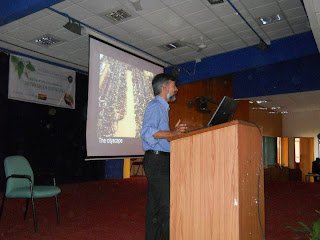Members of KANS viz. myself, Ananthraj and Harish participated in the elephant estimation exercise carried out by A Rocha and the Karnataka Forest Department.
Background:
-----------
The forests between Karnataka and Tamil Nadu has always been a region of high man-elephant conflict (MEC). In addition, the regional disparities have also played their role with the forest departments of each state blaming the other for 'pushing' elephants to the other region and creating havoc in the agricultural lands. KANS has already completed a study of the MEC with the help of ANCF. ANCF has in the past carried out trials of barriers that could prevent elephants from straying into human habitation.
Objective:
----------
KANS intends to reduce the MEC and for this it was important to understand the elephant behaviour and also understand the stand taken by the forest departments of the two border states in tackling MEC.
A Rocha and the KFD are carrying out this exercise to estimate the number of elephants. This will be followed up with a census in December by when the KFD expects an influx of elephants migrating from Tamil Nadu. Based on the increase, the KFD intends to provide adequate resources to manage MEC and incorporate this in the management plan for BNP.
The event:
----------
The event was addressed by Dr. Vijay from A Rocha who welcomed the volunteers and spoke about the gravity of MEC.![]()
He was followed by the DCF Mr. Venkatesh B., who talked about the initiatives taken by the KFD for tackling MEC. There were further talks by the RFO of Anekal range who described the terrain and the constraints and challenges in tackling MEC.
A key point was the fact that from this year onwards the KFD was planning to refrain from pushing back any of the elephant herds migrating towards BNP. All efforts, would in fact, be put into restraining the elephant within the park boundaries. A Rocha was planning to assist in this by putting up 'Chilli-tobacco fence' at the exit areas of the park.
After a quick tea-break, Mr. Gopal Krishna, Senior Researcher A Rocha explained the techniques of the estimation exercise viz. Block count and Water hole count and the procedure to be followed for collating the data.
Subsequently, all the volunteers were divided into 3 teams..one for each range viz. Anekal, Bannerghatta NP and Harohally and they were shunted to their respective ranges.
At Harohalli: Day 1 (Waterhole count):
--------------------------------------
![]()
I was assigned to the Harohalli range. Gopal, who was in charge of the team, assigned the waterholes to each of the volunteers.
![]()
Geri and I were in-charge of the Erle Kallu Katte waterhole. Early on 1st morning, we took off with Gopal 'literally' on the wheel and we were dropped at our respective water holes. Bhommaiah was the guard entrusted with our lives, in case we were attacked by elephants.
![]()
Soon as we disembarked, we did a quick recce of the waterhole and found a shady spot where we could have our packed breakfast of pulav. Geri and Bhoomaiah dug into their b/f while I decided to stave off the hunger. Having experienced this at Ramanakere at Bhadra Tiger Reserve in May 2007, I knew that hunger will keep knocking at our stomach doors all day and I had realised that 'delayed gratification' was the only solution.
The hours ticked by slowly. No sign of elephants and Mr. Bhoomaiah was getting restless. While he suggested that we move to a higher altitude from where there is a possibility of sighting wildlife, we explained to him that the objective of the exercise was not to sight wildlife. For that we could have visited Bannerghatta Zoo!!
Soon after lunch, we undertook a quick 1 hr trek to a nearby hillock where we say a lot of elephant activity.![]()
Upon our return, I continued my new hobby of chucking pebbles at frogs and towards evening we were joined by Senthil and Aruna who had spent the day at a nearby water hole.
Gopal came to pick us up, and in the intervening period the guards tried to make things a little exciting by narrating stories of people attacked by elephants and by alighting some of the bombs that had been given to us to scare elephants in case we ran into them!
There was a welcome surprise for us when we returned to the range office at Harohally. Lilavati (Lily) from BNP had been brought into town to carry the local diety, Chamundeshwari Devi, the next morning.
![]()
At Harohally: Day 2 (Block count):
----------------------------------
The team composition was changed slightly. I was teamed with Mr. Narayana Forest Guard. Enthusiastic fellow that he was, we scoured the block that we were assigned (Bheemadoddana halli to Ravutanahalli dam) up and down, criss cross...but no direct or indirect signtings :)
![]()
Finally at around 11.30 am we called it a day and caught up with the other teams who had to be picked up. Rajath and Shashi, however decided to play truant and did not appear till nearly 2pm while the actual reporting time for all the teams was 12 pm. Thankful that we were to see them in a single piece, we left for Kalkere where we had to assemble and share notes and make a quick estimation of the number of elephants.
The final count, arrived at after hearing from everyone was that the NP had around 50 elephants!
Conservation Notes:
-------------------
- The information received from the field staff was inconsistent. While one guard categorically said that elephants always come from TN, another said that KFD also pushes elephants to TN resulting in the TNFD and local TN villagers together pushing back an equal or higher number of elephants back into BNP.
- According to one of the field staff, there are nearly 300 elephants in BNP!
- According to one of the field staff, cattle grazing can be strictly curtailed but due to the ongoing crop-raiding, the KFD also seeks cooperation from the villagers and hence the cattle grazing threat is not seriously addressed.
- The neighbouring Kanakapura Reserve Forests can be notified and included within the BNP. The FD staff in Kanakapura RFs take bribes to allow live stock grazing and this puts the BNP staff in an uncomfortable situation.
- The count of elephants significantly increases during the months of Oct-Feb. This is primarly due to elephants migrating from South to North. These forests and the ones in the Hosur Forest Division receive most of the rain from the North-East monsoon and hence elephants have traditionally moved from South to North in search of water and food.
- The migratory behaviour brings a lot of pressure on the neighbouring agricultural lands which are raising fresh crops after the rains. The FD tries to control this through night vigil and firing bombs.
- The reason for crop raiding has to be ascertained. While it is clear that they find crops more palatable, the fact that the forests do not have ample fodder is a matter of concern. One reason for this could also be the degradation of the forest from livestock from the villages.
- Elephant population has also been increasing due to the protection measures adopted by the FD. However, the measures such as creation of artificial water holes should be analyzed properly. Wildlife should be left to remain wild. There should be no human intervention in providing them with fodder and water e.g. artificial water holes. This is the manner in which nature keeps a check on the population and any human intervention will lead to imbalance and could result in unpleasant actions such as culling!!!
Participants:
KANS Members:
-------------
Laxmeesha
Ananthraj
Harish
![]()
Others (in Harohally team):
-------
Rachana Patwardhan
Geraldine Fernandes
Aruna Vedale
Chitman Kaur
Shashikala
UdayKumar S.
Sunil Karthik
Senthil
Rajath Ravindran
Ayaraj
Suresh
-
Laxmeesha Acharya
President
Kenneth Anderson Nature Society
Background:
-----------
The forests between Karnataka and Tamil Nadu has always been a region of high man-elephant conflict (MEC). In addition, the regional disparities have also played their role with the forest departments of each state blaming the other for 'pushing' elephants to the other region and creating havoc in the agricultural lands. KANS has already completed a study of the MEC with the help of ANCF. ANCF has in the past carried out trials of barriers that could prevent elephants from straying into human habitation.
Objective:
----------
KANS intends to reduce the MEC and for this it was important to understand the elephant behaviour and also understand the stand taken by the forest departments of the two border states in tackling MEC.
A Rocha and the KFD are carrying out this exercise to estimate the number of elephants. This will be followed up with a census in December by when the KFD expects an influx of elephants migrating from Tamil Nadu. Based on the increase, the KFD intends to provide adequate resources to manage MEC and incorporate this in the management plan for BNP.
The event:
----------
The event was addressed by Dr. Vijay from A Rocha who welcomed the volunteers and spoke about the gravity of MEC.
He was followed by the DCF Mr. Venkatesh B., who talked about the initiatives taken by the KFD for tackling MEC. There were further talks by the RFO of Anekal range who described the terrain and the constraints and challenges in tackling MEC.
A key point was the fact that from this year onwards the KFD was planning to refrain from pushing back any of the elephant herds migrating towards BNP. All efforts, would in fact, be put into restraining the elephant within the park boundaries. A Rocha was planning to assist in this by putting up 'Chilli-tobacco fence' at the exit areas of the park.
After a quick tea-break, Mr. Gopal Krishna, Senior Researcher A Rocha explained the techniques of the estimation exercise viz. Block count and Water hole count and the procedure to be followed for collating the data.
Subsequently, all the volunteers were divided into 3 teams..one for each range viz. Anekal, Bannerghatta NP and Harohally and they were shunted to their respective ranges.
At Harohalli: Day 1 (Waterhole count):
--------------------------------------
I was assigned to the Harohalli range. Gopal, who was in charge of the team, assigned the waterholes to each of the volunteers.
Geri and I were in-charge of the Erle Kallu Katte waterhole. Early on 1st morning, we took off with Gopal 'literally' on the wheel and we were dropped at our respective water holes. Bhommaiah was the guard entrusted with our lives, in case we were attacked by elephants.
Soon as we disembarked, we did a quick recce of the waterhole and found a shady spot where we could have our packed breakfast of pulav. Geri and Bhoomaiah dug into their b/f while I decided to stave off the hunger. Having experienced this at Ramanakere at Bhadra Tiger Reserve in May 2007, I knew that hunger will keep knocking at our stomach doors all day and I had realised that 'delayed gratification' was the only solution.
The hours ticked by slowly. No sign of elephants and Mr. Bhoomaiah was getting restless. While he suggested that we move to a higher altitude from where there is a possibility of sighting wildlife, we explained to him that the objective of the exercise was not to sight wildlife. For that we could have visited Bannerghatta Zoo!!
Soon after lunch, we undertook a quick 1 hr trek to a nearby hillock where we say a lot of elephant activity.
Upon our return, I continued my new hobby of chucking pebbles at frogs and towards evening we were joined by Senthil and Aruna who had spent the day at a nearby water hole.
Gopal came to pick us up, and in the intervening period the guards tried to make things a little exciting by narrating stories of people attacked by elephants and by alighting some of the bombs that had been given to us to scare elephants in case we ran into them!
There was a welcome surprise for us when we returned to the range office at Harohally. Lilavati (Lily) from BNP had been brought into town to carry the local diety, Chamundeshwari Devi, the next morning.
At Harohally: Day 2 (Block count):
----------------------------------
The team composition was changed slightly. I was teamed with Mr. Narayana Forest Guard. Enthusiastic fellow that he was, we scoured the block that we were assigned (Bheemadoddana halli to Ravutanahalli dam) up and down, criss cross...but no direct or indirect signtings :)
Finally at around 11.30 am we called it a day and caught up with the other teams who had to be picked up. Rajath and Shashi, however decided to play truant and did not appear till nearly 2pm while the actual reporting time for all the teams was 12 pm. Thankful that we were to see them in a single piece, we left for Kalkere where we had to assemble and share notes and make a quick estimation of the number of elephants.
The final count, arrived at after hearing from everyone was that the NP had around 50 elephants!
Conservation Notes:
-------------------
- The information received from the field staff was inconsistent. While one guard categorically said that elephants always come from TN, another said that KFD also pushes elephants to TN resulting in the TNFD and local TN villagers together pushing back an equal or higher number of elephants back into BNP.
- According to one of the field staff, there are nearly 300 elephants in BNP!
- According to one of the field staff, cattle grazing can be strictly curtailed but due to the ongoing crop-raiding, the KFD also seeks cooperation from the villagers and hence the cattle grazing threat is not seriously addressed.
- The neighbouring Kanakapura Reserve Forests can be notified and included within the BNP. The FD staff in Kanakapura RFs take bribes to allow live stock grazing and this puts the BNP staff in an uncomfortable situation.
- The count of elephants significantly increases during the months of Oct-Feb. This is primarly due to elephants migrating from South to North. These forests and the ones in the Hosur Forest Division receive most of the rain from the North-East monsoon and hence elephants have traditionally moved from South to North in search of water and food.
- The migratory behaviour brings a lot of pressure on the neighbouring agricultural lands which are raising fresh crops after the rains. The FD tries to control this through night vigil and firing bombs.
- The reason for crop raiding has to be ascertained. While it is clear that they find crops more palatable, the fact that the forests do not have ample fodder is a matter of concern. One reason for this could also be the degradation of the forest from livestock from the villages.
- Elephant population has also been increasing due to the protection measures adopted by the FD. However, the measures such as creation of artificial water holes should be analyzed properly. Wildlife should be left to remain wild. There should be no human intervention in providing them with fodder and water e.g. artificial water holes. This is the manner in which nature keeps a check on the population and any human intervention will lead to imbalance and could result in unpleasant actions such as culling!!!
Participants:
KANS Members:
-------------
Laxmeesha
Ananthraj
Harish
Others (in Harohally team):
-------
Rachana Patwardhan
Geraldine Fernandes
Aruna Vedale
Chitman Kaur
Shashikala
UdayKumar S.
Sunil Karthik
Senthil
Rajath Ravindran
Ayaraj
Suresh
-
Laxmeesha Acharya
President
Kenneth Anderson Nature Society


